TOYOTA YARIS HYBRID 2012 Owners Manual
Manufacturer: TOYOTA, Model Year: 2012, Model line: YARIS HYBRID, Model: TOYOTA YARIS HYBRID 2012Pages: 704, PDF Size: 27.58 MB
Page 341 of 704
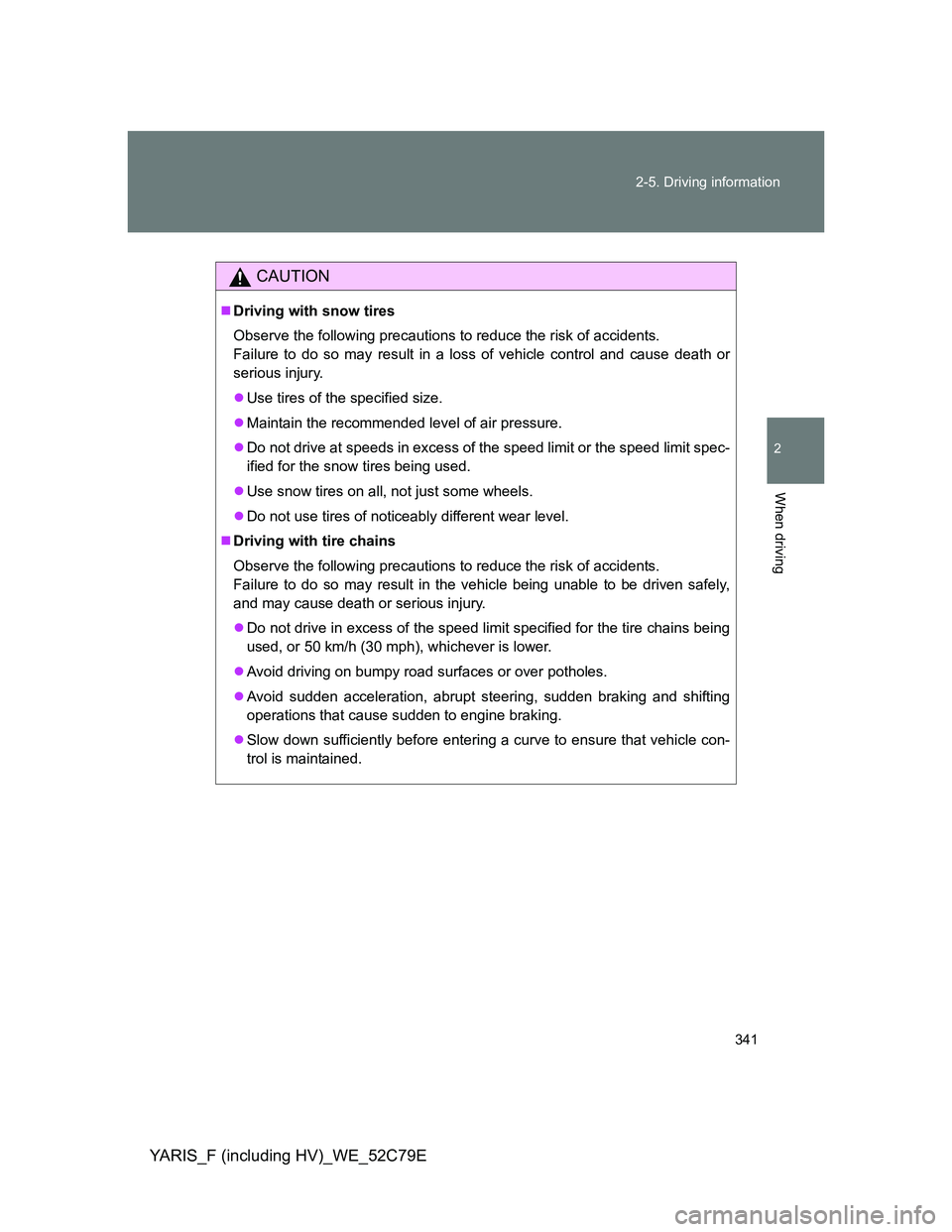
341 2-5. Driving information
2
When driving
YARIS_F (including HV)_WE_52C79E
CAUTION
Driving with snow tires
Observe the following precautions to reduce the risk of accidents.
Failure to do so may result in a loss of vehicle control and cause death or
serious injury.
Use tires of the specified size.
Maintain the recommended level of air pressure.
Do not drive at speeds in excess of the speed limit or the speed limit spec-
ified for the snow tires being used.
Use snow tires on all, not just some wheels.
Do not use tires of noticeably different wear level.
Driving with tire chains
Observe the following precautions to reduce the risk of accidents.
Failure to do so may result in the vehicle being unable to be driven safely,
and may cause death or serious injury.
Do not drive in excess of the speed limit specified for the tire chains being
used, or 50 km/h (30 mph), whichever is lower.
Avoid driving on bumpy road surfaces or over potholes.
Avoid sudden acceleration, abrupt steering, sudden braking and shifting
operations that cause sudden to engine braking.
Slow down sufficiently before entering a curve to ensure that vehicle con-
trol is maintained.
Page 342 of 704
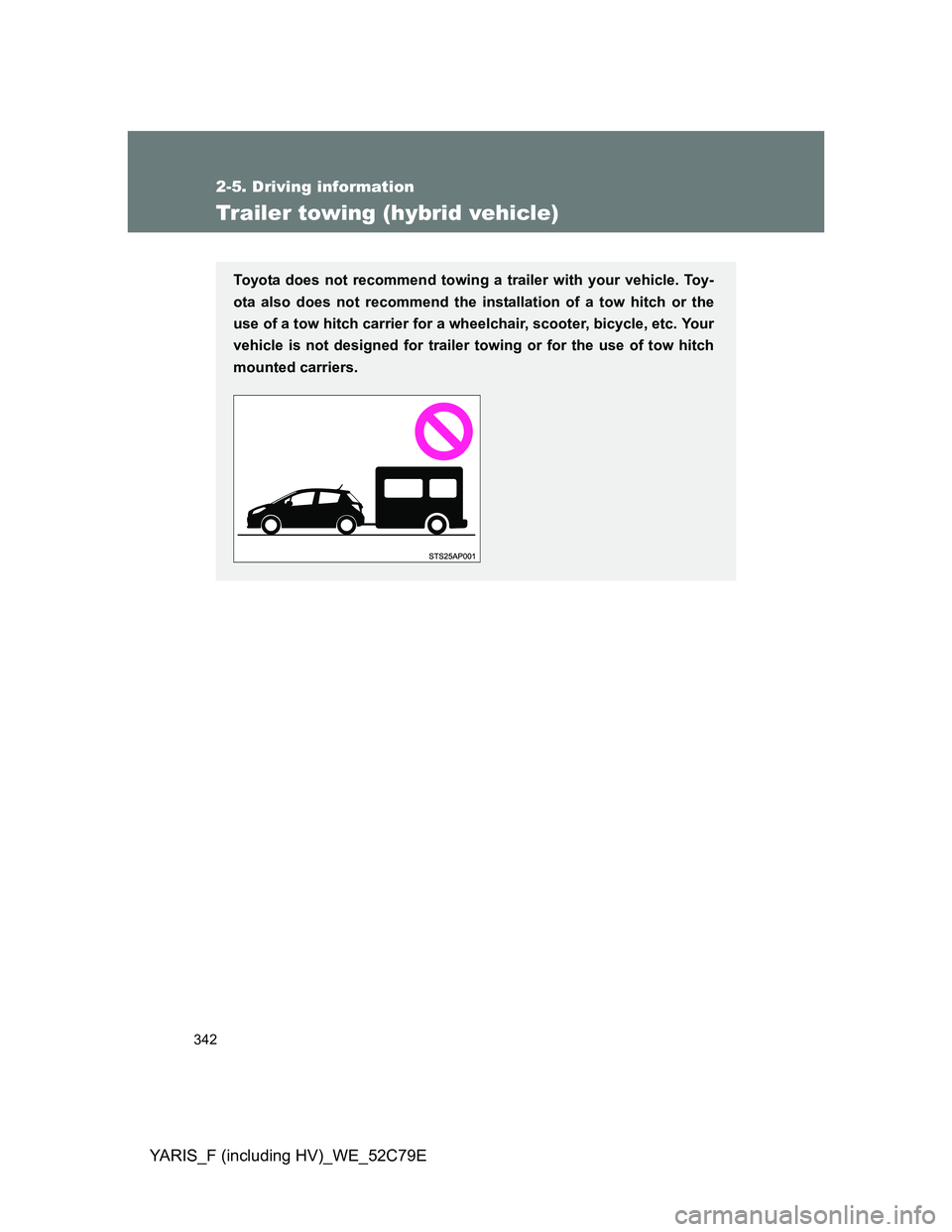
342
2-5. Driving information
YARIS_F (including HV)_WE_52C79E
Trailer towing (hybrid vehicle)
Toyota does not recommend towing a trailer with your vehicle. Toy-
ota also does not recommend the installation of a tow hitch or the
use of a tow hitch carrier for a wheelchair, scooter, bicycle, etc. Your
vehicle is not designed for trailer towing or for the use of tow hitch
mounted carriers.
Page 343 of 704
![TOYOTA YARIS HYBRID 2012 Owners Manual 343
2-5. Driving information
2
When driving
YARIS_F (including HV)_WE_52C79E
Trailer towing (except hybrid vehicle [except for South Africa])
Your vehicle is designed primarily as a passenger carrying TOYOTA YARIS HYBRID 2012 Owners Manual 343
2-5. Driving information
2
When driving
YARIS_F (including HV)_WE_52C79E
Trailer towing (except hybrid vehicle [except for South Africa])
Your vehicle is designed primarily as a passenger carrying](/img/14/60989/w960_60989-342.png)
343
2-5. Driving information
2
When driving
YARIS_F (including HV)_WE_52C79E
Trailer towing (except hybrid vehicle [except for South Africa])
Your vehicle is designed primarily as a passenger carrying vehicle.
Towing a trailer will have an adverse effect on handling, perfor-
mance, braking, durability, and fuel consumption. Your safety and
satisfaction depend on the proper use of correct equipment and cau-
tious driving habits. For your safety and the safety of others, do not
overload the vehicle or trailer.
To tow a trailer safely, use extreme care and drive the vehicle in
accordance with the trailer’s characteristics and operating condi-
tions.
Toyota warranties do not apply to damage or malfunction caused by
towing a trailer for commercial purposes.
Ask your local authorized Toyota dealer or repairer, or another duly
qualified and equipped professional, for further details before tow-
ing, as there are additional legal requirements in some countries.
Weight limits
Check the allowable towing capacity, GVM (Gross Vehicle
Mass), MPAC (Maximum Permissible Axle Capacity), and per-
missible drawbar load before towing. (P. 654)
Towing hitch/bracket
Toyota recommends the use of the Toyota hitch/bracket for your
vehicle. Other products of a suitable nature and comparable
quality may also be used.
Page 344 of 704
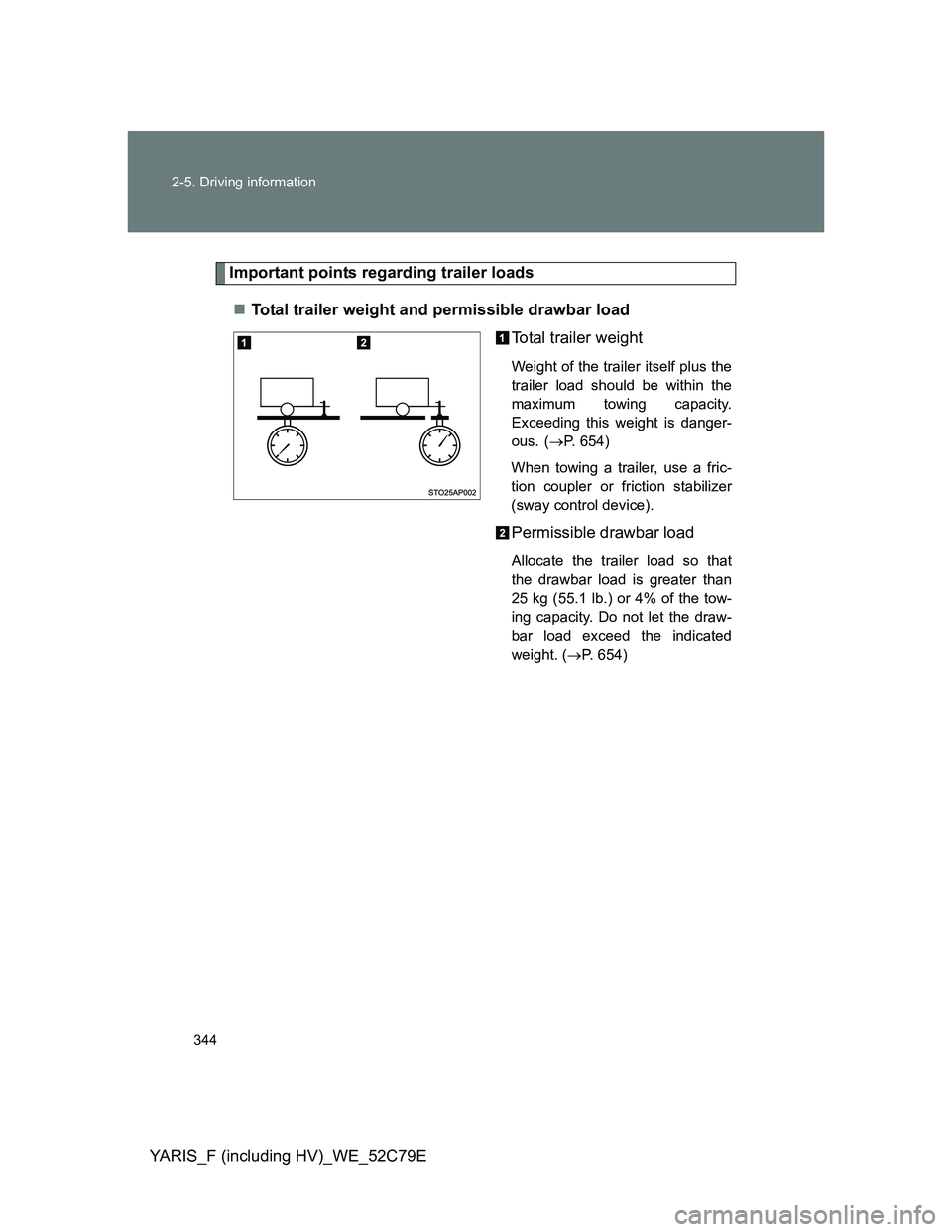
344 2-5. Driving information
YARIS_F (including HV)_WE_52C79E
Important points regarding trailer loads
Total trailer weight and permissible drawbar load
Total trailer weight
Weight of the trailer itself plus the
trailer load should be within the
maximum towing capacity.
Exceeding this weight is danger-
ous.
(P. 654)
When towing a trailer, use a fric-
tion coupler or friction stabilizer
(sway control device).
Permissible drawbar load
Allocate the trailer load so that
the drawbar load is greater than
25 kg (55.1 lb.) or 4% of the tow-
ing capacity. Do not let the draw-
bar load exceed the indicated
weight. (P. 654)
Page 345 of 704
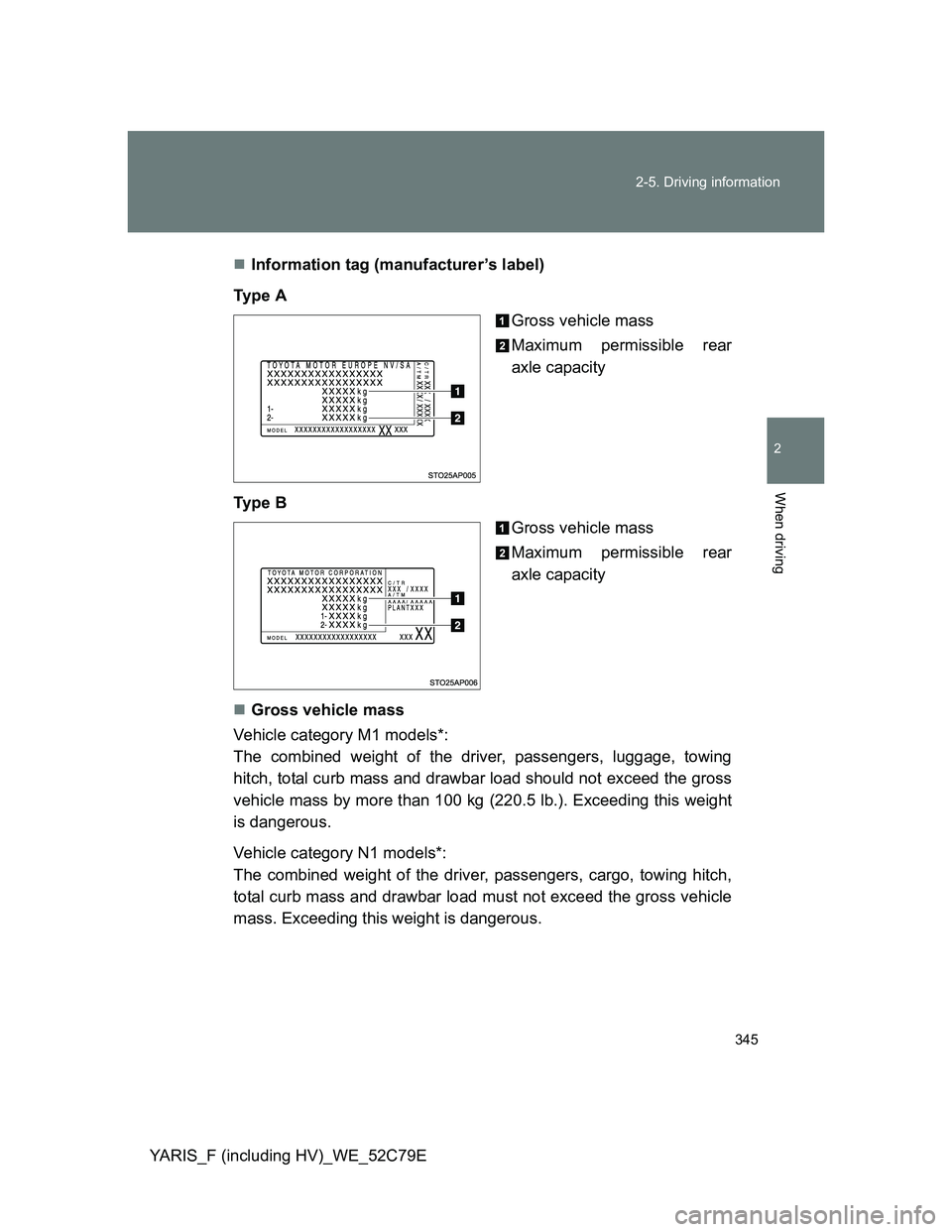
345 2-5. Driving information
2
When driving
YARIS_F (including HV)_WE_52C79EInformation tag (manufacturer’s label)
Ty p e A
Gross vehicle mass
Maximum permissible rear
axle capacity
Ty p e B
Gross vehicle mass
Maximum permissible rear
axle capacity
Gross vehicle mass
Vehicle category M1 models*:
The combined weight of the driver, passengers, luggage, towing
hitch, total curb mass and drawbar load should not exceed the gross
vehicle mass by more than 100 kg (220.5 lb.). Exceeding this weight
is dangerous.
Vehicle category N1 models*:
The combined weight of the driver, passengers, cargo, towing hitch,
total curb mass and drawbar load must not exceed the gross vehicle
mass. Exceeding this weight is dangerous.
Page 346 of 704
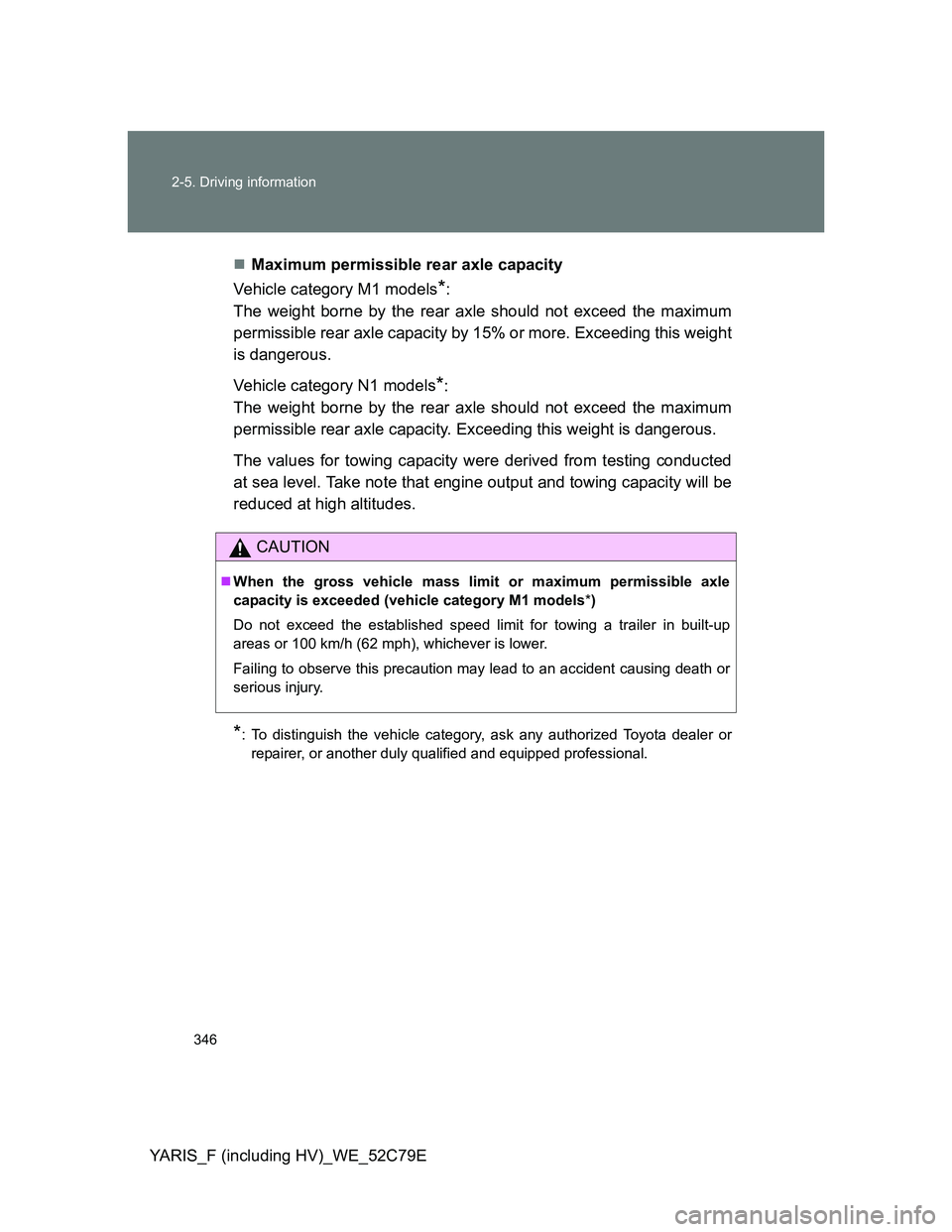
346 2-5. Driving information
YARIS_F (including HV)_WE_52C79EMaximum permissible rear axle capacity
Vehicle category M1 models
*:
The weight borne by the rear axle should not exceed the maximum
permissible rear axle capacity by 15% or more. Exceeding this weight
is dangerous.
Vehicle category N1 models
*:
The weight borne by the rear axle should not exceed the maximum
permissible rear axle capacity. Exceeding this weight is dangerous.
The values for towing capacity were derived from testing conducted
at sea level. Take note that engine output and towing capacity will be
reduced at high altitudes.
*: To distinguish the vehicle category, ask any authorized Toyota dealer or
repairer, or another duly qualified and equipped professional.
CAUTION
When the gross vehicle mass limit or maximum permissible axle
capacity is exceeded (vehicle category M1 models*)
Do not exceed the established speed limit for towing a trailer in built-up
areas or 100 km/h (62 mph), whichever is lower.
Failing to observe this precaution may lead to an accident causing death or
serious injury.
Page 347 of 704
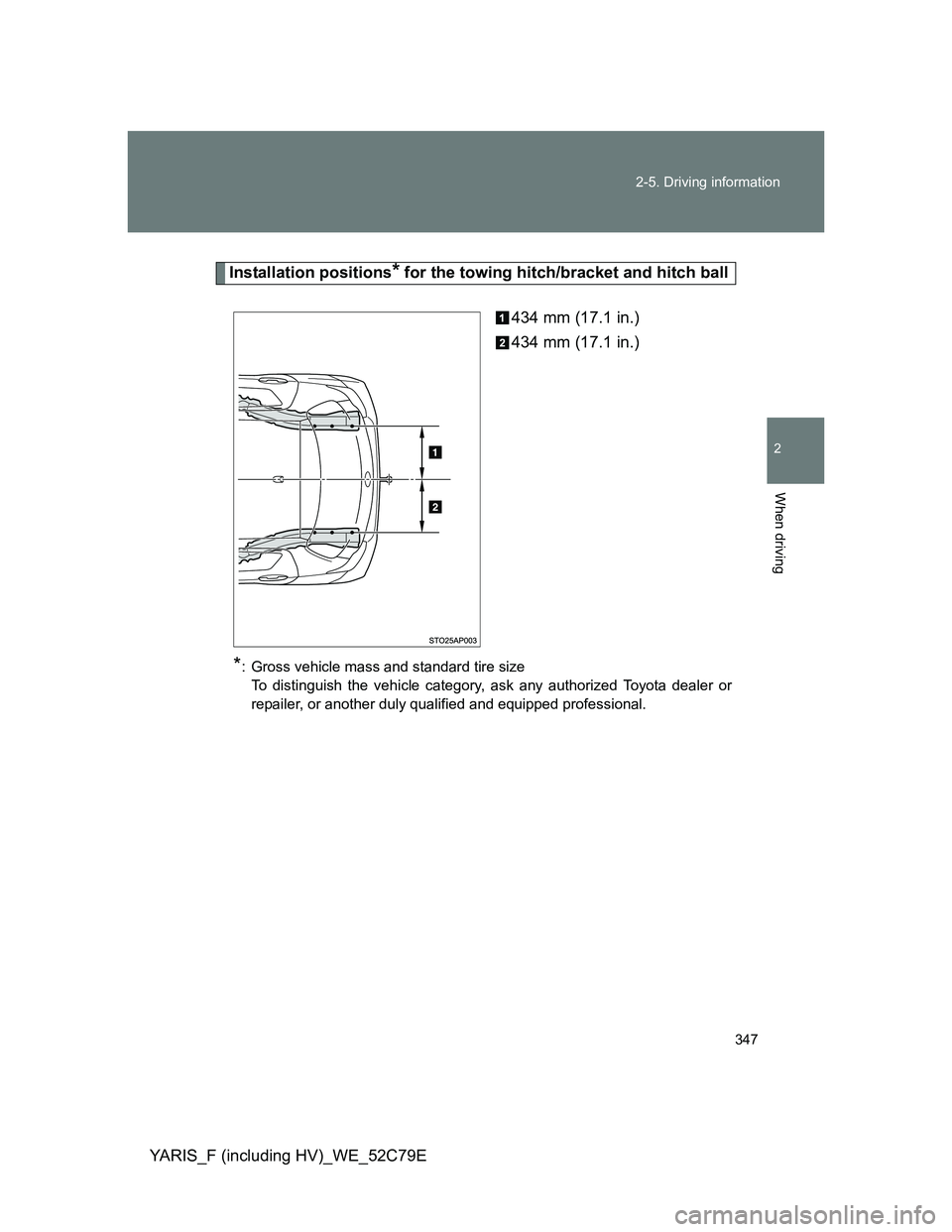
347 2-5. Driving information
2
When driving
YARIS_F (including HV)_WE_52C79E
Installation positions* for the towing hitch/bracket and hitch ball
434 mm (17.1 in.)
434 mm (17.1 in.)
*: Gross vehicle mass and standard tire size
To distinguish the vehicle category, ask any authorized Toyota dealer or
repailer, or another duly qualified and equipped professional.
Page 348 of 704
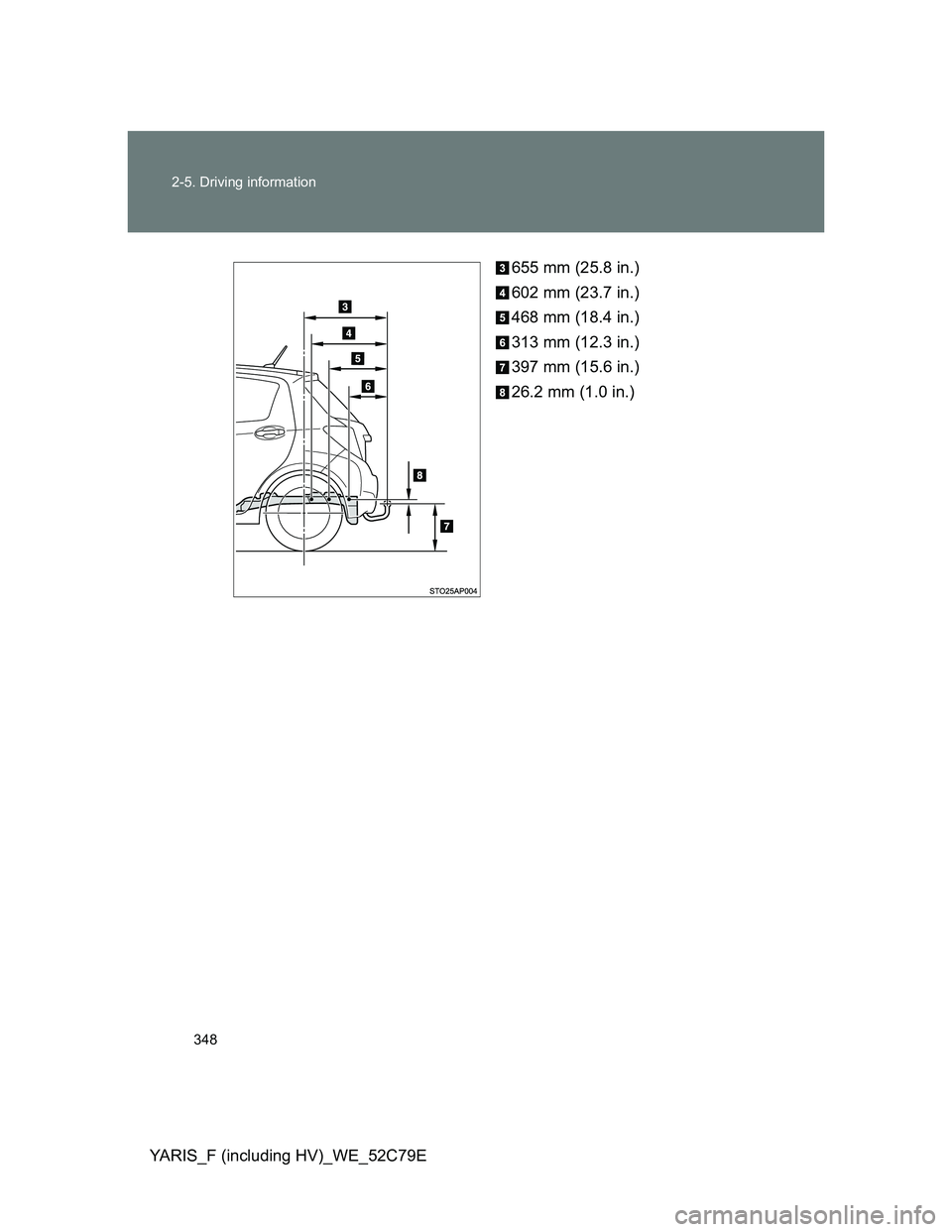
348 2-5. Driving information
YARIS_F (including HV)_WE_52C79E655 mm (25.8 in.)
602 mm (23.7 in.)
468 mm (18.4 in.)
313 mm (12.3 in.)
397 mm (15.6 in.)
26.2 mm (1.0 in.)
Page 349 of 704
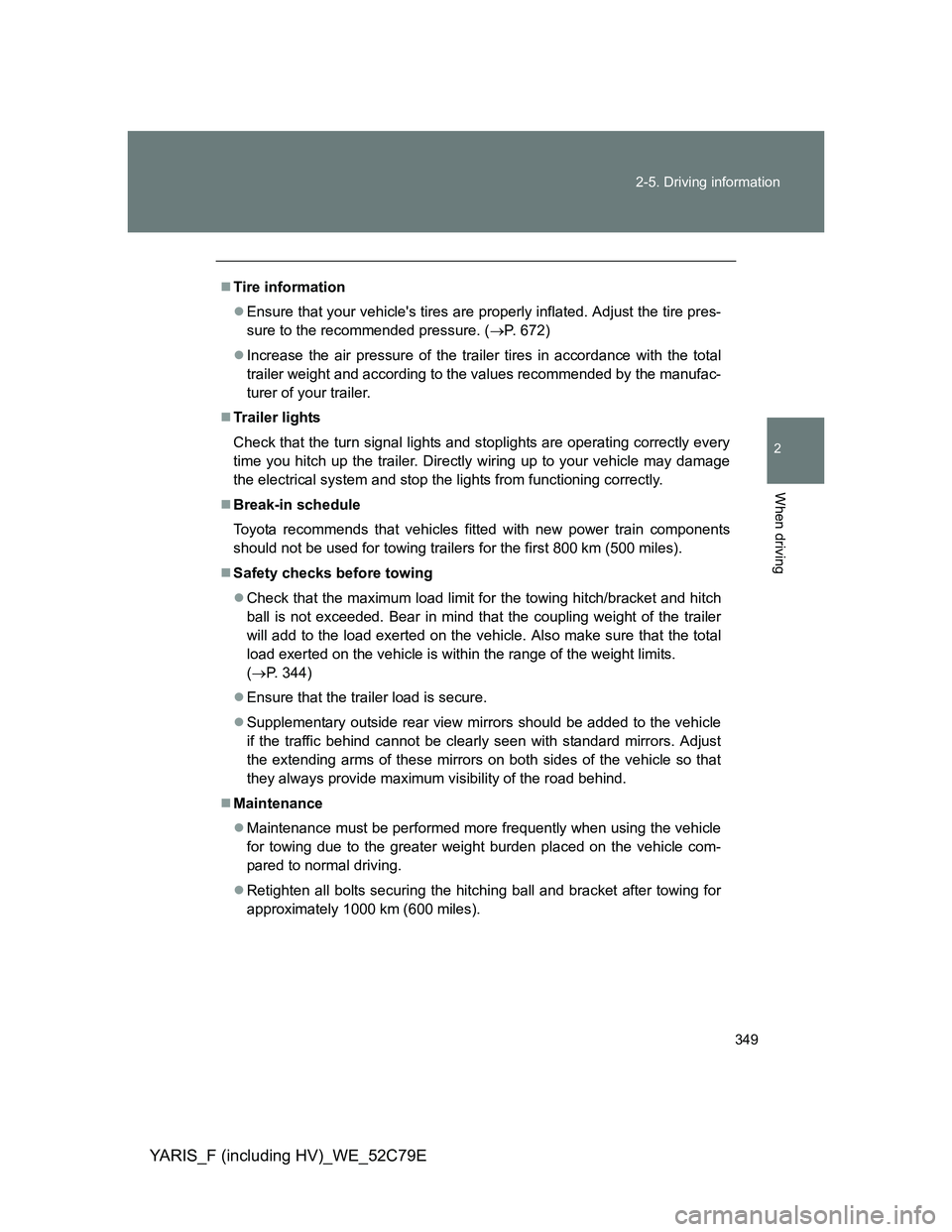
349 2-5. Driving information
2
When driving
YARIS_F (including HV)_WE_52C79E
Tire information
Ensure that your vehicle's tires are properly inflated. Adjust the tire pres-
sure to the recommended pressure. (P. 672)
Increase the air pressure of the trailer tires in accordance with the total
trailer weight and according to the values recommended by the manufac-
turer of your trailer.
Trailer lights
Check that the turn signal lights and stoplights are operating correctly every
time you hitch up the trailer. Directly wiring up to your vehicle may damage
the electrical system and stop the lights from functioning correctly.
Break-in schedule
Toyota recommends that vehicles fitted with new power train components
should not be used for towing trailers for the first 800 km (500 miles).
Safety checks before towing
Check that the maximum load limit for the towing hitch/bracket and hitch
ball is not exceeded. Bear in mind that the coupling weight of the trailer
will add to the load exerted on the vehicle. Also make sure that the total
load exerted on the vehicle is within the range of the weight limits.
(P. 344)
Ensure that the trailer load is secure.
Supplementary outside rear view mirrors should be added to the vehicle
if the traffic behind cannot be clearly seen with standard mirrors. Adjust
the extending arms of these mirrors on both sides of the vehicle so that
they always provide maximum visibility of the road behind.
Maintenance
Maintenance must be performed more frequently when using the vehicle
for towing due to the greater weight burden placed on the vehicle com-
pared to normal driving.
Retighten all bolts securing the hitching ball and bracket after towing for
approximately 1000 km (600 miles).
Page 350 of 704
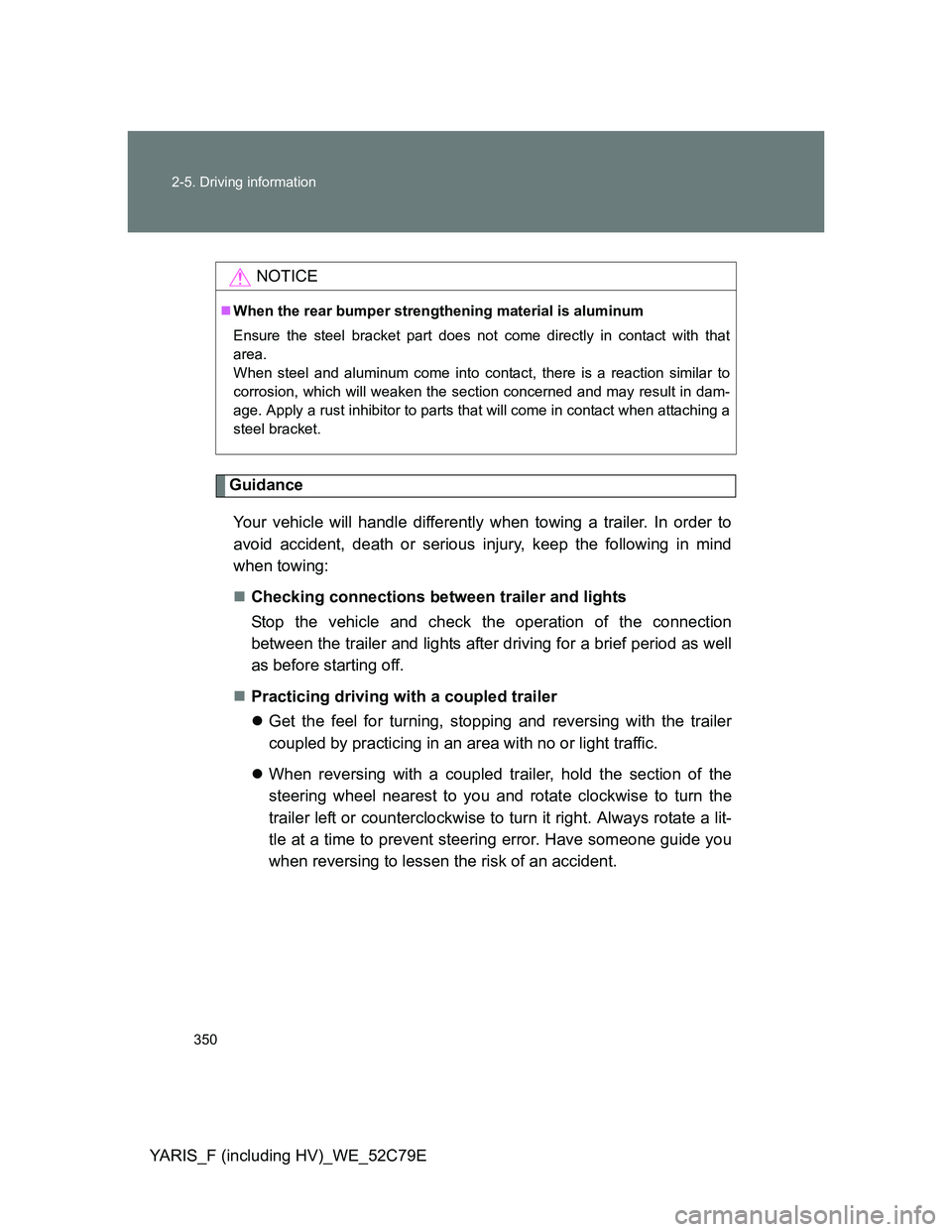
350 2-5. Driving information
YARIS_F (including HV)_WE_52C79E
Guidance
Your vehicle will handle differently when towing a trailer. In order to
avoid accident, death or serious injury, keep the following in mind
when towing:
Checking connections between trailer and lights
Stop the vehicle and check the operation of the connection
between the trailer and lights after driving for a brief period as well
as before starting off.
Practicing driving with a coupled trailer
Get the feel for turning, stopping and reversing with the trailer
coupled by practicing in an area with no or light traffic.
When reversing with a coupled trailer, hold the section of the
steering wheel nearest to you and rotate clockwise to turn the
trailer left or counterclockwise to turn it right. Always rotate a lit-
tle at a time to prevent steering error. Have someone guide you
when reversing to lessen the risk of an accident.
NOTICE
When the rear bumper strengthening material is aluminum
Ensure the steel bracket part does not come directly in contact with that
area.
When steel and aluminum come into contact, there is a reaction similar to
corrosion, which will weaken the section concerned and may result in dam-
age. Apply a rust inhibitor to parts that will come in contact when attaching a
steel bracket.